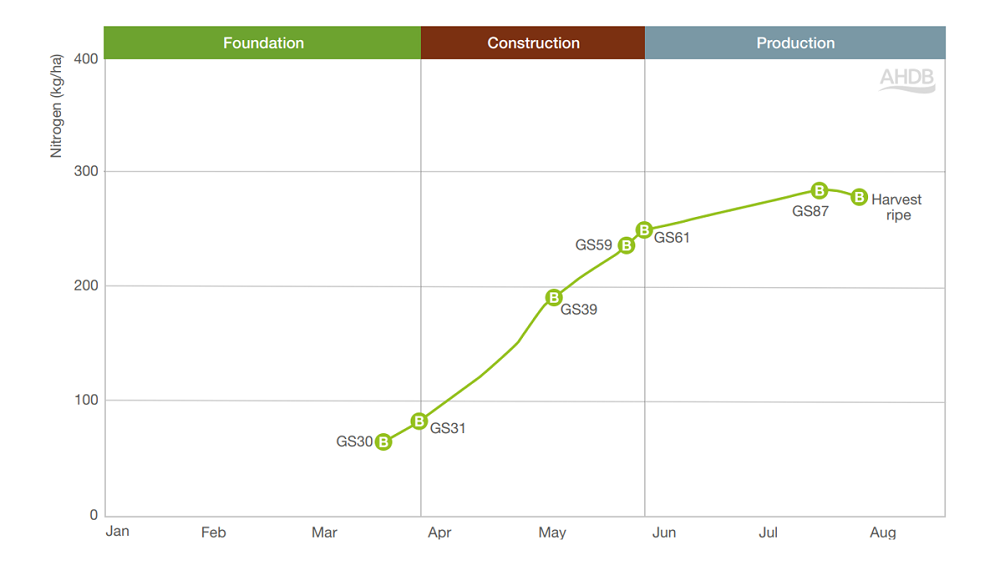- Home
- Knowledge library
- Nitrogen supply, demand and utilisation in winter wheat
Nitrogen supply, demand and utilisation in winter wheat
Around half of wheat nitrogen (N) demand is met from soil supply, with the other half coming from applied nitrogen fertilisers. Find out about the sources of nitrogen and the crop growth stages when it is taken up.
Growth guides for wheat, barley and oilseed rape
Key facts about nitrogen use in wheat
- Soil nitrogen (N) release and crop recovery are variable
- Soils N supply is usually sufficient for wheat to produce roughly half its unlimited yield
- Applied fertiliser N is usually sufficient for wheat to realise roughly half its unlimited yield – 40% and 10% from the first and second halves of N applied, respectively
- Fertiliser N controls canopy size, primarily through shoot number
- Most N is taken up around May (linked to canopy expansion)
- During grain filling, a large proportion of N in leaves and stems is redistributed to grain
Sources of wheat nitrogen
Benchmark: 75 kg/ha available soil N
Influences: Cropping history, previous fertiliser applications (including manure), soil type, crop residues, cultivations, soil organic matter
Seed contributes about 5 kg N/ha, while 20–40 kg/ha comes from the atmosphere, in rain and N-containing gases. However, most is acquired from soil.
The benchmark is 75kg/ha available N (nitrate and ammonium) at soil N supply (SNS) Index 1. In the UK, more than 50% of soils are Index 1 or above.
Soil N availability is increased by unrecovered fertiliser from previous crops or organic residues, such as legume roots or animal manures.
Soil N release is stimulated in warm, moist soils and after cultivations that thoroughly disturb the soil. N from a previous crop is released in autumn, with the extent crop-dependent – to a greater (e.g. oilseed rape and peas) or lesser (e.g. beans) extent
Crop residues with low N, such as straw, can ‘lock up’ nitrogen and cause temporary unavailability. However, some N is released after a previous cereal crop through re-mineralisation of previously immobilised fertiliser N.
Uptake of soil N continues throughout growth. Early sowing and unimpeded rooting improve soil N uptake.

Canopy nitrogen requirement
Benchmark: 36kg/ha per unit GAI N
Varietal influence: Low
Other influences: Limited – little variation in value
N uptake has a major influence on a crop’s green canopy. The way N controls canopy expansion depends on the stage of crop development.
Soil N is particularly prone to leaching when uptake is low due to slow canopy expansion over winter. As temperatures rise, canopy expansion accelerates and demand for N increases.
Throughout development, the area of green tissues relates to the amount of N they contain; there is about 36kg N/ha of green tissue. Thus, it is possible to control canopy size by controlling N availability.
N uptake affects canopy size by promoting tillering (before stem extension), shoot survival and some increase in final leaf size (during stem extension) and prolonged survival of yield-forming leaves (after stem extension).
Pattern of nitrogen uptake
Benchmark: 81 kg/ha from sowing to first node (GS31)
Benchmark: 167 kg/ha from first node to flowering
Varietal influence: Low
Other influences: N supply
By harvest, a typical crop takes up 279 kg/ha:
- 30% before first node emergence (GS31)
- 40% between first node and flag leaf (only five weeks) – mainly to produce the top ‘yield-forming’ leaves within a crop’s canopy
- 20% between flag leaf and flowering
- 10% after flowering

How to measure cereal plant populations and nitrogen uptake
Nitrogen redistribution to grain
Benchmark: 158 kg/ha transferred to grain
Benchmark: 90 kg/ha left in chaff, straw and stubble
Varietal influence: Low
Other influences: Crop N content
During grain filling, there is a large redistribution of N within the crop, as proteins in the leaves are degraded and N is transferred to form grain protein. This, not root uptake during grain filling, is the main source of grain N. At harvest, chaff, straw and stubble contain 90 kg N/ha –158 kg/ha less than at flowering.
Occasionally, crop N decreases slightly before harvest, probably due to loss of leaves.
How to manage nutrients in cereals (RB209)
 AHDB.JPG)
Topics:
Sectors:
Tags:

